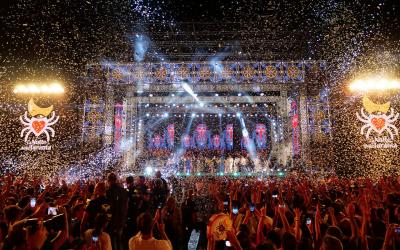Southern Italy’s spider-induced pagan Tarantella dance spawns major festival

MELPIGNANO -- Southern Italy’s infamous Tarantella dance, punctuated by tambourines and convulsive, eerie movements symbolically replicating the body suffering and then expelling poisonous spider venom, has today developed into a unique 200,000-strong music festival in the depths of southern Italy.
The Notte della Taranta, or Night of the Taranta, which draws international crowds and top-end musical performers every year, takes place end-August in celebration of this deep, dark pre-Christian pagan dance that embodies a ritual, an exorcism and a form of entertainment
for locals and foreigners alike. The lively movements and musical style find their origin in the Italian region of Puglia, the heel of Italy’s boot, though traces of it span wide across the nation’s south.
This dance, known as the tarantella or pizzica, traces its roots back to ancient times, rooted in the wild celebrations of Dionysian and Bacchanalian rites. In this mesmerizing ambiance, quartets of young men, tambourines in hand, gather in jubilant circles. The air is electric as
dancers – both female and male - whirl with frenetic abandon, seemingly in a trance. Their movements lead musicians to match their tempo, as if engaged in spirited duels.
“The Night of the Taranta is linked to the phenomenon of tarantism, widespread throughout the Mediterranean area, connected to spider bites and affecting rural areas, causing a general sense of malaise with prostration and widespread pains,” said Salvatore Esposito,
Taranta expert and editor of Blogfolk, a magazine specialising in Italian traditional and folk music. “The cure for this condition consisted of a musical and choreatic therapy during which the victim was brought into a trance state, and through dance, a purification ritual
and catharsis were achieved through music.”
“Industrialization and the gradual decline of rural life led to the disappearance of tarantism, but not to the musical tradition associated with it,” he told Italian Insider. In fact, once believed to possess mystical powers, the tarantella transformed over time.
Initially regarded as a means of exorcising spider bites and psychological afflictions during the Middle Ages, it has shed its mystical guise. Today, tambourines, mandolins, flutes, bagpipes, and accordions infuse the tarantella with effervescent vitality, offering
entertainment, enjoyment, relaxation.
And so for one extraordinary night each year during the Night of the Taranta the picturesque yet miniscule town of Melpignano becomes a crossroads of cultures and melodies. Here, the local pizzica and tarantella dances transcend their origins, embracing a
global flair. Jazz, rock, salsa, and folk music from diverse traditions converge, lending an international cadence to the celebration. Past editions have drawn audiences from across the world despite their having to patiently brave the infrastructure limits posed by a small Italian village home usually to a mere 2,300 residents. In the past, world-famous artists the likes of Balkan musician Goran Bregovic; Stewart Copeland of The Police fame; and Joe
Zawinul from the Weather Report have been drawn into its folds.
“The Notte della Taranta is one of the most important historical renditions in Italy, and it’s also a way of inviting people to understand what the roots are of these places,” said Italian singer, actress, and television personality Arisa (Rosalba Pippa), who sang at this
year’s event. “The south of Italy has been contaminated by many different cultures, thanks to the attractive weather, agriculture and culture, and the locals would learn and absorb from people coming in from outside.”
This year the ceremonial director of the event was Italian singer and songwriter Fiorella Mannoia. Also present were Brunori Sas, an Italian singer from the southern Italian region of Calabria who shot to fame for his Albanian-dialect renditions, and Italian singer-songwriter,
rapper and record producer Tananai (Alberto Cotta Ramusino.) Pre-opening act Nidi d'Arac garnered a particularly warm applause from the hundreds of thousands present.
The pizzica is a serious matter,” Fiorella said. “You can’t risk going wrong when you enter such a frenetic rhythm.”
The vibrant festival always unfolds against the backdrop of a 16th-century sand-coloured limestone monastery, where a sprawling stage is been erected to become the focal point of the festival and the setting for an enchanting spectacle that captivates the hundreds of
thousands present. The air as always this year was charged with the rhythm of tambourines and guitars long before the official concert started.
Like past years, music and atmosphere this year fused history with modernity, tradition with innovation, uniting individuals in a harmonious tapestry of sound and movement.
“It’s one of Europe’s most important cultural events and reflects the mixture of culture embodied in Italy over the past centuries,” said Italian Culture Minister Gennaro Sangiuliano. “It’s a community and identity-related event that brings people together,
something that is absolutely needed today.”
Next year, Notte della Taranta will be held Aug. 24.
jp-at
Q
© COPYRIGHT ITALIAN INSIDER
UNAUTHORISED REPRODUCTION FORBIDDEN


